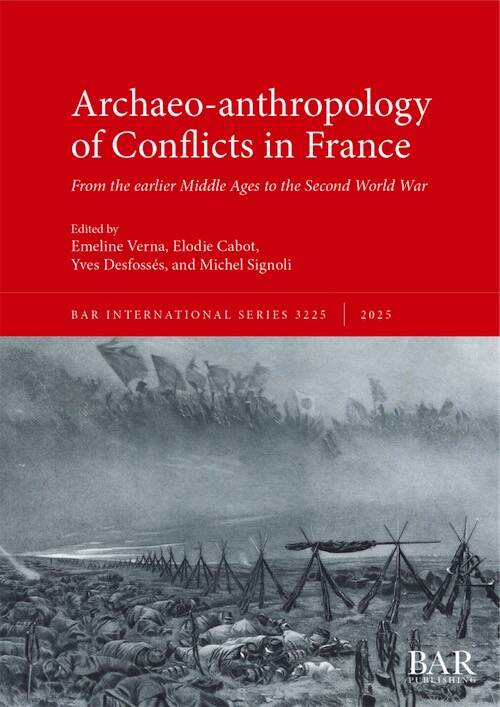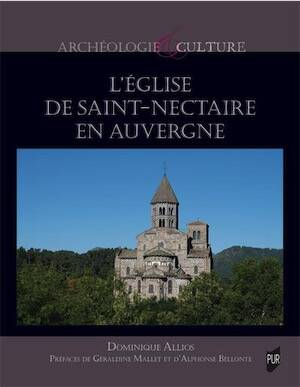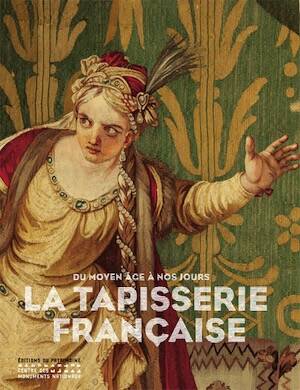- Search
- Advanced search

New
Archaeo-anthropology of Conflicts in France. From the earlier Middle Ages to the Second World War, (BAR S3225), 2025, 200 p. -
This work is the result of a collective research project, Archaeology and Anthropology of Conflicts (2020-2022), which brought together around thirty researchers from various disciplinary backgrounds in anthropology, archaeology, history, and genetics. Its aim was both to inventory sites related to these contexts and to illustrate, through specific cases, the diversity of situations encountered across time and space.
War often leads to extraordinary mortality, raising questions about how the living adapt to the abnormality of death in the management of the deceased. How did survivors, comrades-in-arms, enemies, or even civilians handle corpses, balancing funeral traditions with urgent sanitary concerns?
This volume brings together twenty articles that highlight the wide variety of funerary practices, and presents burial sites ranging from the Early Middle Ages to the twentieth century. These sites are analyzed through both an archaeological and a memorial perspective.
Sommaire :
Part I. Some examples of conflicts over the centuries: from early Middles Ages to 19th
- Kill, Die, Bury: War Violence in the Early Middle Ages (J. Roul)
- The Battle of Verneuil (17 August 1424) from the Battlefield Archaeology viewpoint (T. Guérin)
- A crisis cemetery from the late Middle Ages in Anzin-Saint-Aubin (Pas-de-Calais) (L. Dalmau, D. Delobel)
- Auxi-le-Château (France, 16th - 17th century): a group of soldiers from the France-Spain realms border (A. Mayer, P. Lhommel, R. Barbieri, M. Signoli, C. Costedoat)
- A skeleton on the island of Houat, witness to the Franco-English naval wars of the 16th-17th centuries (E. Cabot, M. Ducloyer, G. Visseaux)
- From Archaeology to History: the Case of Mortality Crisis Management in Nice (Alpes-Maritimes) at the End of the Modern Period (B. Jossier, F. Lelandais, R. Mercurin)
- Between war and epidemic: an anthropological approach to a soldiers' grave during the War of Spanish Succession (Douai)(M. Signoli)
- Mass graves from the battle of Le Mans (1793) (E. Cabot, P. Chevet, V. Gendrot)
- Soldiers from An II in the Trois-Maisons cemetery in Nancy (Meurthe-et-Moselle)(S.Tzortzis, L. Lanteri, M. Dhor-Combe, M. Signoli)
- The battle of Reichshoffen-Woerth (August 6, 1870): the French 99th regiment (E. Verna, M. Meucci, T. Vette, C. Costedoat)
- Giving a name to the deceased: the use of genetic tools in the process of identifying soldiers (C. Costedoat)
Part II. The two World Wars on French soil
- Some cases of isolated burials of soldiers of World War I (Aisne) (N. Robin, G. Desplanque)
- The burial trench at the Châtelet-sur-Retourne site (August 1914) (E. Verna et al.)
- Identifying Commonwealth Soldier through War Trauma: A Case Study of Private Herbert Greaves (L. Margely-Lardeyret, S. Naji)
- Discovery of three German soldiers of the First World War: 1914 in Boissy-Frenoy (Oise)(D. Veyssier)
- Land-use planning and the accidental discovery of military mortal remains: how to find the right balance? The case of Ablaincourt-Pressoir (M. Meucci et al.)
- Janus - Looking Back, Looking Forward: A Retrospective on the Recovery and Analysis of Artefacts for Identifying World War One Soldiers from Mass Graves, Fromelles, Northern France .(L. Loe, M. Cox, K. Brady)
- An archaeology of medicine during the Great War: Excavation of the Hospital Center in Savenay (Loire-Atlantique) and the American hospitals in Western France (1917–1920)(A. Le Boulaire)
- Discovery and identification of a Second World War Moroccan rifleman (M. Meucci, E. Verna, C. Costedoat)
- Beauvais (Oise): Study of a Luftwaffe temporary cemetery, 1940–1942(L. Bouniol, J.-M. Femolant, E. Verna)
- Conclusion (E. Verna, E. Cabot, Y. Desfossés, M. Signoli)
Référence : 58067.
English
85,00 €
In the same Epoch




